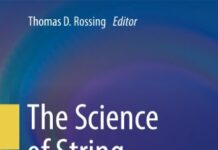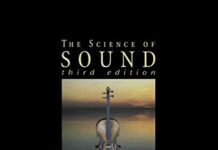
Ebook Info
- Published: 2004
- Number of pages: 344 pages
- Format: PDF
- File Size: 6.81 MB
- Authors: Thomas D. Rossing
Description
An ideal text for advanced undergraduates, the book provides the foundations needed to understand the acoustics of rooms and musical instruments as well as the basics for scientists and engineers interested in noise and vibration. The new edition contains four new chapters devoted primarily to applications of acoustical principles in everyday life: Microphones and Other Transducers, Sound in Concert Halls and Studios, Sound and Noise Outdoors; and Underwater Sound.
User’s Reviews
Editorial Reviews: Review From the reviews of the second edition:”This book is designed to serve as a text for an introductory course in acoustics for physics or engineering students. … On the basis of its clear and concise exposition of a mix of basic and applied subject matter, I would recommend this book for consideration as a text in an introductory acoustics course. … I again wish to acknowledge the overall excellence of Principles of Vibration and Sound as a solid text for introductory acoustics.” (Arnold Tubis, Journal of the Acoustical Society of America, Vol. 116 (5), 2004) From the Back Cover An ideal text for advanced undergraduates, Principles of Vibration and Sound, Second Edition provides the foundations needed to understand the acoustics of rooms and musical instruments, as well as the basics for scientists and engineers interested in noise and vibration. The Second Edition contains four new chapters devoted primarily to applications of acoustical principles in everyday life: Microphones and Other Transducers; Sound in Concert Halls and Studios; Sound and Noise Outdoors; and Underwater Sound.Rossing and Fletcher present the physics of mechanical vibrating systems, emphasizing normal modes of vibration. Beginning with the basics of free and forced motions of simple harmonic oscillator (with electrical analogs indicated where appropriate), they then proceed to vibrations in one-dimensional systems, such as strings and bars, and two-dimensional systems, such as membranes and plates.The discussion of coupled systems includes strong as well as weak coupling and presents both mechanical and electrical examples. The treatment includes a fairly detailed discussion of nonlinear systems and self-excited oscillators, as well as a brief explanation of modal analysis, including finite-element methods and modal testing. The second part of the book discusses the propagation of sound in air, including radiation, transmission, absorption, and diffraction. This treatment of radiation covers point, dipole, line, plane and other sources, both with and without baffles, and the propagation of sound in various kinds and shapes of pipes, horns and other acoustics components.About the authors:Thomas Rossing is Professor Emeritus of Physics at Northern Illinois University. He is a Fellow of the American Physical Society, Acoustical Society of America and the American Association for the Advancement of Science. He has authored 10 other books.Neville Fletcher is Professor Emeritus of Physics of the University of New England in Australia and is now a Visiting Fellow at the Australian National University. He is a Fellow of the Australian Academy of Science, the Australian Academy of Technological Sciences and Engineering, the Acoustical Societies of both America and Australia, and the Institutes of Physics of both Australia and the UK. He has authored four other books.
Reviews from Amazon users which were colected at the time this book was published on the website:
⭐The book by Rossing and Fletcher is a portion of the wonderful Physics of Musical Instruments by the same authors and it accordingly covers all the background material in waves and vibrations that might be applicable to that topic. This book, unlike “Physics of Musical Instruments”, was written as a textbook rather than a reference. This book omits EM waves, but covers most of the other necessities. Most of the chapters conclude with brief Appendices going into greater detail on specific topics. All the problems are collected at the back of the book and they are too few and stated, perhaps, a bit too briefly. You should probably be an advanced undergraduate with courses in engineering physics, acoustics, and mathematics through ordinary and partial differential equations in order to get the most from this book.The book begins with free and forced vibrations of simple systems. The complex exponential function is immediately employed and superposition of more than one harmonic motion is considered. Energy, damping, some exemplary systems, including the RLC circuit are done before driving force, resonance and transient response are introduced. Then oscillations in two dimensions and the normal mode problem for coupled mass-spring systems are done. The chapter ends with a few comments on nonlinearities, so a lot happens in this first chapter.Chapter 2 does waves in continuous, one-dimensional systems, mostly strings and bars. It begins with a nice segue from the loaded string to the massive string, then derives the wave equation for a stretched string and then solves it. Then reflection at fixed and free ends is done followed by the harmonic solutions, standing waves and energy. Then in considering the plucked string, the main ideas of Fourier analysis are derived and then applied also to the struck string. Consistent with the musical motivation of the book the authors continue on to consider the bowed string. Next impedance is discussed and then the motion of the end supports, another unusual topic of clear musical relevance. Then various loss mechanisms are considered, before longitudinal oscillations are considered. The system in mind here is a thin, solid bar with fixed or free ends. Various non-idealities in both strings and bars are next considered, so that one has nonlinearities and dispersion.Chapter 3 is on two dimension oscillations of membranes and plates. There is nice coverage of the normal modes in rectangular and circular geometry, so the Bessel function makes an untypical appearance. Various appropriate boundary conditions are handled and Chladni patterns shown. Even wooden plates are considered so that the vibration of violin parts can be discussed. Nonlinearities are again considered due to their relevance to many musical applications.Chapter 4 is devoted to coupled vibrating systems starting with coupled pendula. The coupled equations of motion are solved in the usual way and not explicitly related to the eigenvalue problem. Then forcing is considered and other coupled vibrating systems including electrical circuits and mass-spring systems. Then higher numbers of masses are considered and the solution even more resembles that of the eigenvalue problem, but it is still not referred to by that name. The chapter concludes with the coupling of two vibrating strings on an instrument and the bridge that supports them both.Chapter 5 is on nonlinear systems, the Duffing equation being the first example treated. The chapter is quite short and technical and does not cover the chaotic motion of simple driven damped systems.Chapter 6 is on sound waves in air, and starts by deriving the wave equation. Then one dimensional solutions are given, followed by generalization to three dimensions in both rectangular and spherical geometry. The transformation of the Laplacian operator to spherical coordinates and the solutions to the wave equation are simply stated, not derived. Then sound intensity and pressure level are discussed and related to human hearing. Reflection, transmission and absorption by boundaries are discussed, leading up to the normal modes of cavities with application to the acoustics of auditoriums.Chapter 7 covers sound sources and radiation, starting with point source waves and the interference of sound waves from separated point sources. Then arrays of sources are considered, and spherical, line and planar sources, all with obvious relevance to music production by speakers and instruments.Chapter 8 is on pipes and horns. Unsurprisingly this book covers the resonances of and radiation from pipes much more thoroughly than typical texts. Conical and flared pipes are covered in pleasing detail, which is probably too much for the typical course on vibrations and waves.Chapter 9 is on acoustic systems with an emphasis on frequency analysis, coupling, and multi-port systems. This is not a thorough chapter on acoustics, though, and the reader should either already be familiar with basic acoustics or look for a more advanced reference.Chapter 10 is on microphones, loudspeakers, hydrophones, and transducers. An emphasis is on the modeling and mathematics behind such devices, otherwise known as electroacoustics. A good companion book to this chapter is “Introduction to Electroacoustics and Audio Amplifier Design” by Leech, which goes into great detail on the modeling of these devices.Chapter 11 is about sound in concert halls and studios. Although there is mathematics in this chapter as in all chapters, this one is more subjective. For example, it talks in more of an essay style about what makes a room have good acoustics, plus the difference in what is good acoustically for a house of worship versus a classroom.Chapter 12 moves the discussion of acoustics to the outdoors. Here we see topics not previously discussed such as the effects of aircraft, automotive, and even railroad noise on outdoor acoustics. The mathematics of atmospherics are also mentioned.Chapter 13 is a very short chapter on underwater acoustics, and seemed rather tacked on, as underwater acoustics is a very complex topic. A good companion to this chapter is the excellent, “Principles of Underwater Sound” by Urick. It costs $60, but believe it or not, is far cheaper than anything else of its high quality on the subject.In summary, this book is an excellent book on the subject of vibrations and sound, especially the part that overlays the authors’ “Physics of Musical Instruments”, which would be chapters one through eight. Further volumes that will help you with all of the math and physics in this book are Kinsler’s “Fundamentals of Acoustics”, “Introduction to Partial Differential Equations with Applications” by Zachmanoglou, and finally, an out-of-print work: “Schaum’s Outline of Acoustics” by Seto, ISBN 0070563284.
⭐I am a contemporary of T.R. and his spewing of trifle on this subtext is of little interest to those who really know. He is an elitist of the highest order, and should no longer be allowed to contaminate real science with his kibble. A total plagiarism of Helmholtz. Check for yourself.
⭐Some years ago, I bought the first edition of this book because, at first glance, it seemed to present a readable discussion of a very difficult subject. However, as I read further, I realized that the writing is very terse and imprecise. Most annoyingly, it was full of typographical errors.This semester I am working with two students on an independent study project on vibration and sound. We decided to use the second edition of this book as one of our sources. To my complete amazement and dismay, the second edition has at least as many typographical errors as the first edition. It is incredibly frustrating to spend half an hour trying to justify an equation, only to realize that “x” should be “y”, or “less than” should be “greater than”, or “sin” should be “cos”.I can recommend this book only if you know enough about the subject to realize what the authors actually meant to say, despite what is written in the book.
⭐
⭐
Keywords
Free Download Principles of Vibration and Sound 2nd Edition in PDF format
Principles of Vibration and Sound 2nd Edition PDF Free Download
Download Principles of Vibration and Sound 2nd Edition 2004 PDF Free
Principles of Vibration and Sound 2nd Edition 2004 PDF Free Download
Download Principles of Vibration and Sound 2nd Edition PDF
Free Download Ebook Principles of Vibration and Sound 2nd Edition

